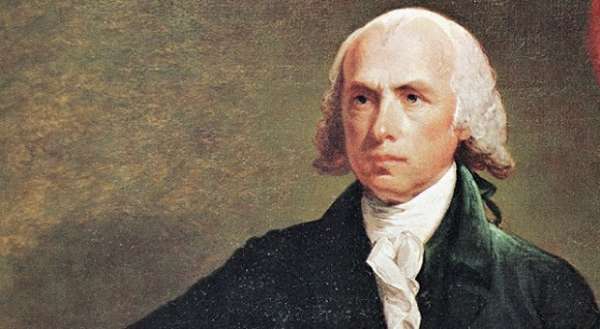
James Madison born on March 16, 1751, in King George County (a colony of Virginia) and died on June 28, 1836, in Orange (Virginia) is a statesman American, 4th president of the United States, based on 1809 to 1817.
Member of the Republican-Democratic Party and delegate of Virginia to the Continental Congress, he is one of the Founding Fathers of the United States. He has considered one of the main authors of the American Constitution; James Madison is particularly concerned with the balance between legislative, judicial and executive powers and the declaration of rights.
He succeeded Thomas Jefferson as Secretary of State for the United States in 1801 before being elected president seven years later. He was also proclaimed a French citizen by the National Legislative Assembly in 1792.
Quick Facts: James Madison
- Known for: America’s 4th President and the “Father of the Constitution”
- Born: March 16, 1751, in King George County, Virginia
- Parents: James Madison, Sr. and Eleanor Rose Conway (Nelly), m. September 15, 1749
- Died: June 28, 1836, in Montpelier, Virginia
- Education: Robertson’s School, College of New Jersey (would later become Princeton University)
- Spouse : Dolley Madison (.M September 15, 1794)
- Children: A stepson, John Payne Todd
The Early Life of James Madison
James Madison, Jr. was born on a plantation in a small estate in Virginia on 16 March of 1751 (March 5, 1751, in the old calendar, the Julian calendar ), where his mother had returned to her parents ‘ house to give birth. He grew up as the eldest of twelve children.
Nelly and James Sr. had seven more boys and four girls. Three of James Jr’s brothers die as children, including one who was stillborn. In the summer of 1775, his sister Elizabeth Madison (7 years old) and his brother Reuben (3 years old) died of dysentery from the epidemic that sweet orange County because of contaminated water.
Her father, James Madison, Sr. (1723-1801), was a tobacco grower who grew up on a farm, then called Mount Pleasant, in Orange County, Virginia, which he had inherited when he reached adulthood.
Later, he acquired more goods and slaves, with 5,000 hectares, he became the largest landowner and a leading citizen of Orange County, in Piedmont. James Jr’s mother, Nelly Conway Madison (1731-1829), was born in Port Conway, the daughter of a prominent farmer and tobacco dealer and his wife. Madison’s parents were married on September 15, 1749.
During these years, the southern colonies were becoming a slave society, in which slave labor linked to the economy, and slave owners formed the political elite.
When James Madison was 11, his parents sent him to Tidewater, where he became a student of Donald Robertson, a Scottish teacher who taught several members of prominent families in the southern plantations. Madison learned mathematics, geography, and modern and classical languages.
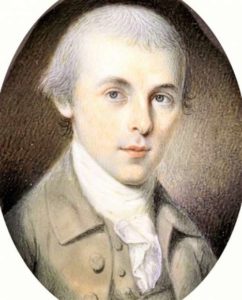
Portrait of James Madison as a student at Princeton University. At 16, Madison returned to Montpelier, where she began a two-year college preparation course with Reverend Thomas Martin. Unlike most young people of his time, James Madison did not want to study at William and Mary University, having opted to enroll at the College of New Jersey (now Princeton University).
The choice was made due to the less disease-prone climate in New Jersey. At university, Madison was a roommate and became a close friend of the poet Philip Freneau and even proposed to his sister, but to no avail.
At university, Madison studied Latin, Greek, Science, Geography, Mathematics, Rhetoric and Philosophy. In addition, oratory and debates were also very important. James Madison was one of the founders of the American Whig Society, the oldest debate society in the United States, and which still exists today.
This society was in direct competition with Aaron Burr’s Cliosophic Society. After graduating in 1771, Madison remained at Princeton to study Hebrew and Political Philosophy with the university’s new president, John Witherspoon, before returning to Montpelier in the spring of 1772.
Marriage and Family
Madison was 43 years old when she first married, which was considered very late at the time. On September 15, 1794, James Madison married Dolley Payne Todd, a 26-year-old widow, in Harewood, West Virginia, a place known today as Jefferson County. Madison never had children but she did adopt Dolley’s son from her first marriage, John Payne Todd, after the bond.
Dolley Payne was born on May 20, 1768, in the Quaker- inhabited ‘New Garden’ settlement in North Carolina where her parents, John Payne and Mary Coles Payne, lived briefly. Dolley’s sister Lucy Payne had recently married George Steptoe Washington, a relative of President Washington.
As a member of Congress, Madison undoubtedly met Widow Todd at her social functions in Philadelphia, the nation’s capital at the time. She had lived there with her deceased husband. In May 1794, Madison asked a mutual friend, Aaron Burr, to make an appointment with Dolley.
In August, Dolley accepted his marriage proposal. By marrying Madison, a bachelor who was not Quakers, Dolley was expelled from her religion, the Society of Friends, which disapproved of marriage to members of other Christian denominations.
The two were known to have a happy marriage. Dolley Madison used her social skills when the two lived in Washington, while James was the secretary of state. When the White House was being built, Dolley advised on decorum and presidency in ceremonial functions for President Jefferson, a widower, and friend of both.
When James became president, Dolley Madison used her position as the president’s wife to advance her husband’s agenda, thereby creating the position of the first lady. She is considered by many to be the reason James was so popular.
James’s father died in 1801 at the age of 78. Madison inherited the large estate in Montpelier and other portfolio securities, in addition to her father’s 108 slaves. He had been driving the paternal properties since 1780.
Political career
His fragile health prevented him from participating in the American Revolutionary War as a fighter. He, therefore, devoted himself energetically to the political life of the young nation. He is the youngest elected member of the continental convention.
He becomes a central figure on the political scene in the state of Virginia, participates in the drafting of the law on religious freedom, and persuades the state to offer the Northwest Territories to Congress (these territories will become a part of Ohio, Kentucky, and Tennessee).
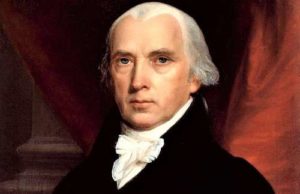
In 1780, he supported the creation of a Constitutional Commission. He was very active during the Philadelphia Convention of which he was the rapporteur and some historians see him as the “father of the Constitution “.
Madison defends the interests of federated states although he is the architect of a system of balance between powers. He insisted on the proportional representation to the population of the States within the Congress.
His notes on the Convention are the best testimony to the ideas of the drafters. He participated in the drafting of the federalist papers, a series of articles in favor of ratification. After the ratification of the Constitution, Madison becomes representative of her state, Virginia.
It was he who introduced the first ten amendments, known as the “Bill of Rights”. He is in favor of limiting the power of the federal government, and it is because of his opposition to the formation of a federal bank that he distances himself from the Federalist Party to get closer to the Republican-Democratic Party.
In 1785, he was also the author of a proposal opposing government funding of Christian schools. Portrait of James Madison at the Secretary of State. In 1797 Madison left Congress to become Jefferson’s secretary of state.
He was one of the main writers of the Resolutions of Virginia in 1798 and of the Report of 1800. In 1808 he ran for president and was elected on December 7, largely due to his diplomatic skill, at a time when France and the United Kingdom are in a period of great tension.
Father of the Constitution
The Articles of the Constitution established the United States as an association of sovereign states with a weak central government. This provision proved to be fruitless after the end of the war. Congress had no powers to levy taxes and no means to pay the debts of the War of Independence, something that worried Madison and other nationalists, such as George Washington and Alexander Hamilton, who feared the country’s bankruptcy and its disunity.
Historian Gordon S. Wood pointed out that many leaders, including Madison and Washington, feared that the Revolution had not solved the social problems that drove it and that the excesses that the population saw in the monarchy passed to lawmakers. According to the same historian, the Shays Rebellion (an attempt to overthrow the government led by war veteran Daniel Shays), was a decisive event for the debate of the government’s organization and whether it would be too democratic.
Madison wrote: “A crisis had come that would make us decide whether the American experience would be a blessing to the world, or put an end to the hopes that the republican cause had inspired forever.”
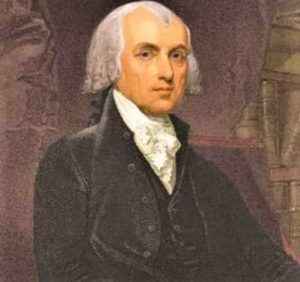
Initially, James Madison hoped to amend the Articles of Confederation and, at the Annapolis Convention, supported the convening of a new convention for this purpose. After winning the elections and winning another term at the Confederation Congress, Madison helped convince other members of Congress to authorize the Philadelphia Convention with the aim of proposing new amendments.
However, Madison had come to believe that the Articles should be deleted in favor of a new constitution, and thus began to prepare to present more than amendments to the convention. Madison helped to convince George Washington to participate in the 1787 convention and knew that his presence would be decisive for the adoption of a new constitution.
A few years earlier, Madison had read a great deal about the various forms of government through books that Thomas Jefferson had sent her from France. Historian Douglas Adair said that Madison’s work was “probably the most prolific academic investigation ever carried out by an American”.
As a quorum was reached to allow a convention, Madison, then 36, wrote what would become known as the Virginia Plan, the general plan for a new constitution. Many delegates were surprised to discover that the plan called for the repeal of the Articles and the creation of a new constitution that should be ratified through special conventions in each state, rather than state legislatures.
However, with the acquiescence of prominent participants such as George Washington and Benjamin Franklin, delegates met in a secret session to debate the creation of a new constitution. Although the Virginia Plan is a general plan and not an outline of an eventual constitution and despite having been substantially altered in the course of the debate (mainly by John Rutledge and James Wilson), its use at the convention led to many calling Madison the “Father of the Constitution”.
Presidency of James Madison
After his inauguration, Madison met immediate opposition by trying to appoint Albert Gallatin as secretary of state. Opposition leader William B. Giles was able to force Madison to appoint Gallatin to the position of Secretary to the Treasury, a position he had held since Jefferson’s previous presidency.
The talented Swiss Gallatin was Madison’s chief adviser, political planner, and confidant. Madison appointed Robert Smith, the secretary of the navy, to the position of secretary of state. For the position of Secretary of the Navy, Madison appointed Paul Hamilton.
Madison’s cabinet, a group of people known to be of mediocre talent, was chosen for the purpose of appeasing the political opposition. When Madison became president in 1809, the federal government had a surplus of $ 9,500,000. By 1810, the national debt fell and taxes were reduced.
War of 1812: Mr. Madison War
When Madison started his second government, the British would still violently attack American ships, seize their cargo, and impress their sailors. Madison asked Congress to declare war: but support for them was far from united.
The war, sometimes called the Second War of Independence (because it led to the end of US economic dependence on Britain), pitted a barely prepared US against the well-trained force that Britain was.
On June 18, 1812, Madison signed a declaration of war against Britain after Congress voted for the first time in American history to declare war against another nation.
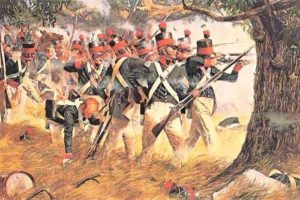
America’s first fight was a disaster called the extradition of Detroit: The British, led by Major General Isaac Brock, and Native American allies led by the leader Tecumseh Shawnee, attacked the port city of Detroit on August 15-16, 1812. US Brigadier General William Hull the city and fortress surrendered, despite having a larger army.
America fared better at sea, and eventually conquered Detroit. The British marched on Washington in 1814, and on August 23 they attacked and burned the White House. Dolley Madison was famous in the White House until they made sure that many national treasures were saved.
The New England federalists met her at the Hartford Convention in late 1814 to discuss the war going out, and there was even talk of secession at the convention. But on December 24, 1814, the United States and Britain agreed on the Ghent Treaty, which ended the fighting but did not resolve any of the pre-war spendings.
Retirement
After his term in office ended, Madison moved to his plantation in Virginia. However, he remained involved in political discourse. He introduced his county to the Virginia Constitutional Convention (1829).
He also spoke against nullification, the idea that states could rule the federal laws unconstitutionally. His Virginia Resolutions were often cited as a precedent for this, but he believed in the power of the Union above all.
He took a leading role in education from the University of Virginia, especially after Thomas Jefferson’s death in 1826. Madison was also a slave-holder Montpelier at a point that had found 118 slaves helped resettle the infamous American Colonization Society to free blacks to help in what would Liberia, Africa.
Death
Although Madison remained vigorous and active during his early retirement after his 80th birthday began in 1829, he began to experience more and more spells of fever and rheumatism.
Eventually, he was confined to Montpelier, although he continued to work when he was able to go through the winter of 1835-1836. On June 27, 1836, he was thanked for several hours. Write to George Tucker who noted his biography of Thomas Jefferson that had dedicated him. He died the next day.
Legacy
Historian Garry Wills wrote: Madison’s claim to our admiration does not detract from a more perfect consistency than it does from his presidency. He has other virtues. As a framer and defender of the constitution, he had no equal.
The finest part of his presidency was his concern for the preservation of the constitution. No man can do everything for the country, not even Washington. James Madison did more, and some things better than anyone else. That was enough.
George F. Will once wrote that “if we truly believe that The pen is mightier than the sword, the capital of our nation would have been called” Madison DC Washington DC instead of ”
Madison’s writings are studied for debates on human rights among different classes of citizens in the 21st century. Madison seems to have anticipated the danger of a strong majority over a weak minority through popular vote. Madison, in The Federalist Papers, in Federalist No. 51, wrote:
“It is of great importance in a republic not only to keep society against the oppression of its rulers but to keep one section of society against the injustices of the other section … In a society in the ways that the strongest faction can easily unite and oppress the weakest, anarchy can truly reign as its natural state where individuals are not insured against the violence of the strongest”.
In 1986, Congress created the James Madison Memorial Fellowship Foundation as part of the bicentennial celebration of the constitution. The foundation offers $ 24,000 in college scholarships to high school teachers for them to earn their master’s degree in Constitution Studies. Montpelier, his family’s estate, has been preserved as a National Historic Landmark.
Many counties, various towns, cities, educational institutions, a mountain range, and a river have been named in honor of James Madison.
[…] was apparently driven by politics to tell the police after he gave up, “Arthur now President of the United States.” He was convicted of murder and hanged on June 30, […]